Starting a business can be exciting until the reality of running it kicks in. Reality would kick so hard that it scatters your attention all over the place.
No matter what happens, though, you want to be making sales or nothing moves. Thus you must market your brand.
According to a CB Insights survey, 14% of startups fail because they didn’t market their product or service properly.
Even worse than poor marketing is that people spend a lot of money trying to sell something that no one needs. The first step to succeeding with ads is determining the demand for the service or product you want to sell.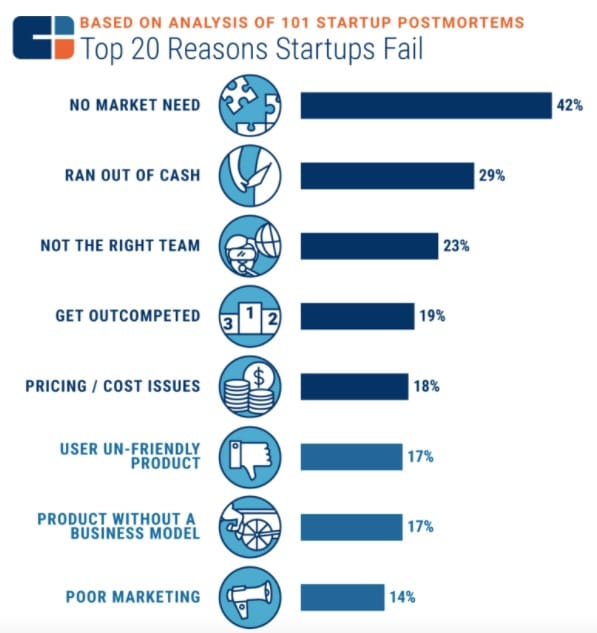
That’s why in my discussion with Lucas Lee-Tyson of Growth Cave, we talk about digital marketing and how to scale your business with it.
Key Takeaways From This Interview
Before you go into the interview, here are some key takeaways from my talk with Lucas Lee-Tyson.
- 30 days is an ideal duration to get results with your advertising
- Startups and established businesses require different marketing strategies.
- Authentic video ads can boost your conversion rates.
- Aim to get results as fast as possible, it keeps your momentum up
- The easiest way to start any business is simply to find a starving market and give them what they want
My Discussion With Growth Cave’s Lucas Lee-Tyson
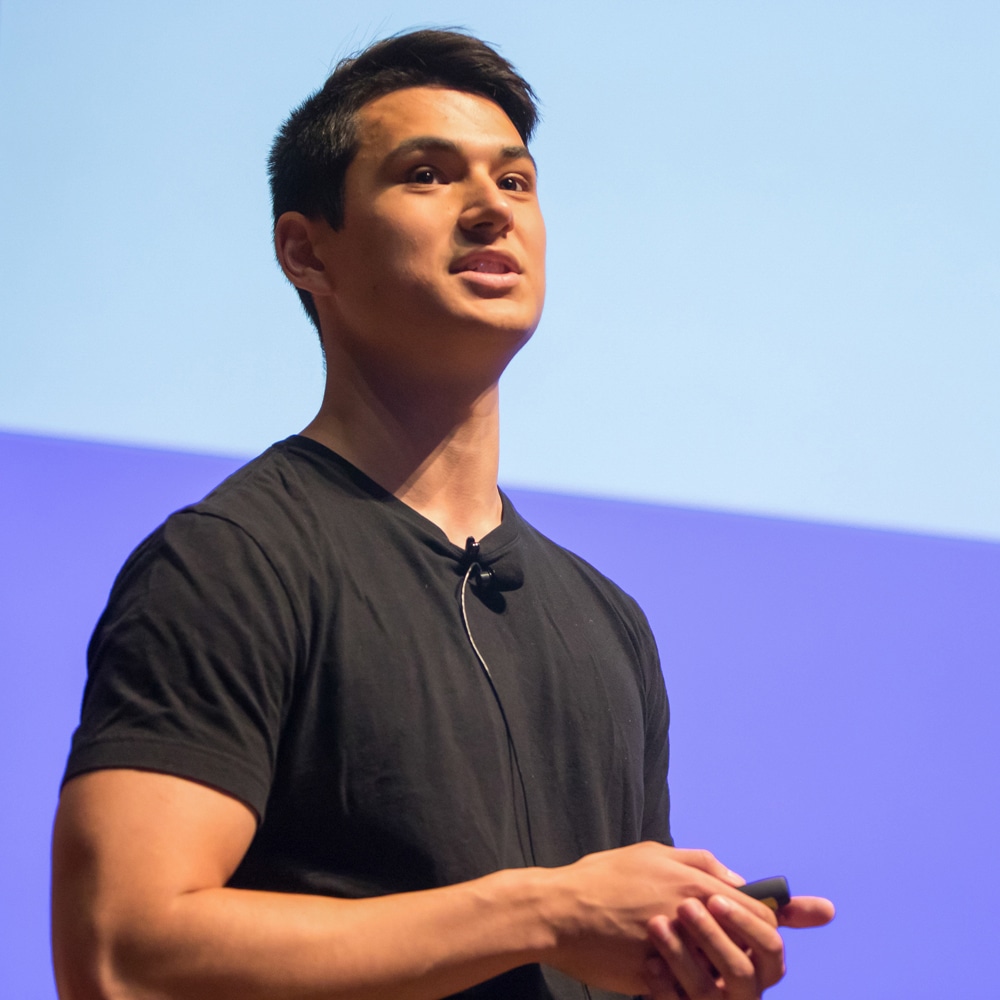
1. Tell us about yourself, what the name, Growth Cave, stands for. And what personal experiences or realizations inspired Growth Cave.
My name’s Lucas Lee Tyson. I’m the founder of a company called Growth Cave.
It’s a digital marketing consulting, training, and service-based business that helps people start and grow businesses, mainly around Facebook advertising.
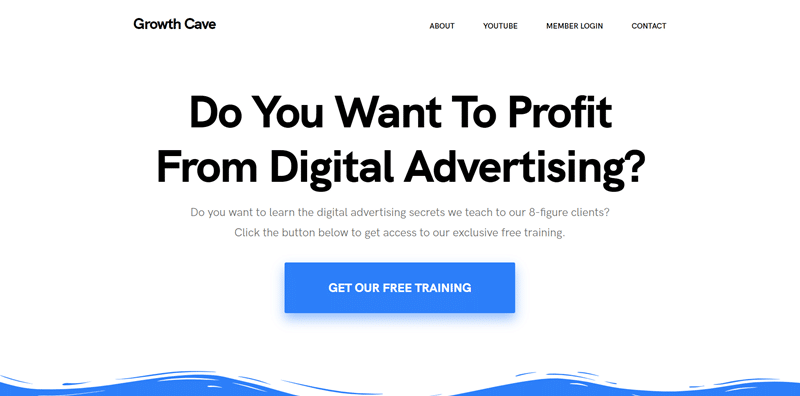
The name itself doesn’t mean anything. I’m pretty sure the only reason I chose it was because the domain name happened to be available.
I was trying to pick out a name for a digital marketing company. It was just one of many that happened to be available. So I ended up going with it. It’s something that I get asked about a lot, and I wish I had a better answer for it.
I’ve been in the online business, internet marketing for a while. I’ve dabbled in all these various areas; starting a blog , starting an e-commerce store. I never really got anywhere, but I definitely picked up a lot of valuable skills as I was trying a lot of these different business models.
One day when I was actually at my day job, I overheard that the company I was working for was spending close to $20,000 per month on paying this digital marketing company to help them run their Facebook ads and their Google ads.
That caused a light bulb to go off in my head, and I thought that instead of just trying to start this new business from scratch, why not help existing businesses that already have a proven concept and already are making money. Like, just help them make more money using digital advertising and digital marketing.
So that was close to probably two and a half years ago now. That’s kind of what laid the groundwork for this business and allowed me to get it up and running.
2. I see you left your 9-5 to start Growth Cave. Tell us about the transition. What lessons did you learn?
It was definitely a transition. The end goal with all of the projects that I had was to have a life of freedom.
I knew the path of nine to five of climbing the corporate ladder for 40 years just to retire when I’m 50 or 60 was not the path that I wanted to go.
I knew there were online business owners and entrepreneurs making a ton of money with their online businesses. I just didn’t really know how to make it happen.
I started to see some positive feedback from the work that I was doing. When I picked up my first few clients, I wasn’t making a ton of money.
My first few clients weren’t paying me thousands of dollars a month. It gave me the confidence that if I can make this first sale, I can make ten more. And if I can make ten more, I can make 50 more. Now it’d be easy enough for me to support myself, quit my job, and go all-in on this.
When I was first getting started, it was definitely difficult because while working nine to five, it’s difficult to structure a business around those times to get a business off the ground full-time while doing that.
It meant working after hours immediately when I got home from work; waking up early, things like that. That was enough to get the ball rolling.
Once I had that proof of concept, the biggest thing for me was figuring out when I wanted to take the leap. When I did take the leap, I had a solid client base of maybe like 3000 or 5,000 a month.
My first few clients weren’t paying me thousands of dollars a month. It gave me the confidence that if I can make this first sale, I can make ten more. And if I can make ten more, I can make 50 more.
It wasn’t millions of dollars, but it was enough in saying that I have this money, I have a little bit of savings. Even if everything goes completely wrong, I was confident enough that I would be able to figure it out.
I knew that if I was going to stay at my job for another three months, another six months, then that was a wasted opportunity. It was wasted time that could have gone into building that business and accelerating me on that path.
So, that part scared me a lot more. Wasting those three to six months scared me a lot more than thinking, what if I quit my job and then ran out of money somehow.
I knew that one of those situations was a lot scarier to me and one that I didn’t want to have to deal with. That gave me a lot of confidence to eventually transition out of that job.
3. Why did you choose to teach what you were learning?
For the first year of the business, I didn’t even have a web presence. I barely had a website, and I was barely building a brand for myself at all.
That was until I actually met one of my current mentors; his name is Brian Harris. He ran a video marketing business helping digital influencers create video content out of their blog posts.
He told me that the business model that I was doing works but revolves completely around me. It revolves around me running people’s ad campaigns, me actually being involved in a business.
I wasn’t actually a business owner, and I was still technically a contractor. That was a realization for me.
The other realization for me was as I started to see some success; I was a part of a lot of online message boards and a bunch of online groups of entrepreneurs.
The natural order of things was when I started seeing success; people started taking note of that. A lot of people started asking questions like, “Oh, I run this type of business. Can you help me with this? Do you think you could teach me things like that?”
At the time, I had never even thought about teaching other people, helping other people, or consulting with other people. It was the combination of those two things and realizing the business model that I was currently operating under was fundamentally broken.
Basically, I was going to hit the ceiling with the amount of money that I could make and the fact that there was a large opportunity for people that needed my help, and I knew I could help them. They were actively asking for it.
That made me realize that if I can offer value this way and I can obviously get paid for it and help them get great results, then there’s no reason that I shouldn’t. This is basically an untapped goldmine of potential people.
So nowadays, we obviously have consulting and training programs. We still have our agency and service side of the business to this day.
Both of them are very interconnected. There’s a lot of overlap between them and the projects that we work on each side and the people that are involved in each of them.
4. In the Productized Profits program, you promised users would get their first client in 30-days. Is this in the best-case scenario or in the worst-case scenario? And is this result typical for everyone?
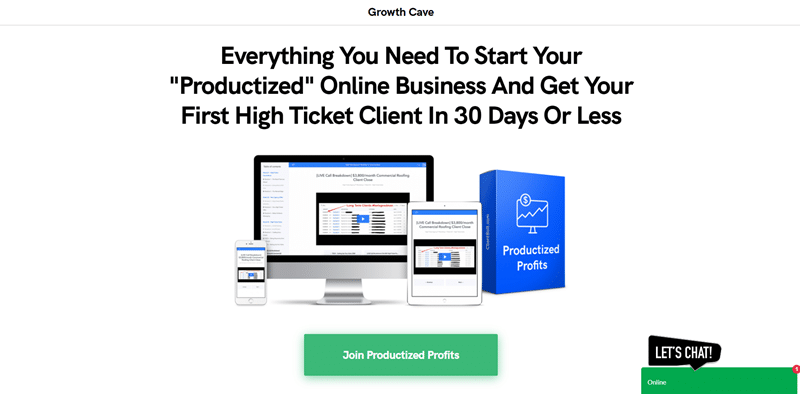
I think 30 days is an ideal length of time. There have been studies done on that. For something to become a habit in someone’s brain, I think it’s 60 days. Then for someone to actually start to see actual results from it is around 30 days.
They talk about that with workout programs that after one month you start to see changes and then after two months people around you start to see changes with yourself. So that was part of it.
…we, as people, naturally want things to happen quickly.
When I was first getting my business started, I didn’t want to have to work another three months, another six months at that job. I wanted to get things moving as quickly as possible.
That’s one of the nice things about the business model that we run and teach. If you’re a hard worker or you’re someone that wants things to happen quickly, there’s no reason it should take longer than 30 days.
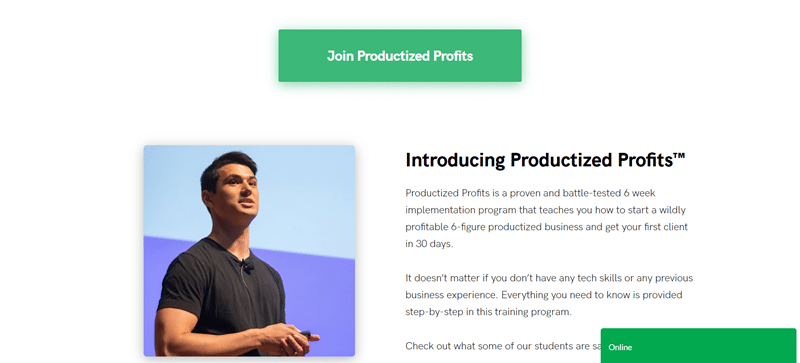
We have people that get the business started, they get everything up and running, and they start getting their first few clients within just a week.
If you really think about it, you’re putting all of your time and effort into reaching out to people, offering your services. There’s no reason it needs to take months at a time.
That said, some people have other things, and some people don’t want to move that quickly. Some people will just want to kind of move at their own pace. And obviously, it takes them a little longer.
But I think 30 days is a really healthy goal for someone that, as I said, is hardworking and committed to hitting their goals.
They obviously have a big reason for why they’re wanting to start this business, whether it’s quitting a job, whether it’s building up siding income, whether it’s having more freedom, whatever it might be.
5. What improvements are you making at the moment for Growth Cave clients?
Yeah. Every day we’re always offering more value and trying to figure out what will help people in their journey.
One of the biggest things that we’ve found is that offering training and consulting through our programs is super helpful and giving them insights into what we’re doing in our business every single day.
The other side of the business that we’re trying to continue working on is the software side.
ClientBolt is actually a software that we co-developed with a software development firm that basically allows a lot of our students and anyone who wants to sign up for it to identify potential business owners that they could reach out to very easily.
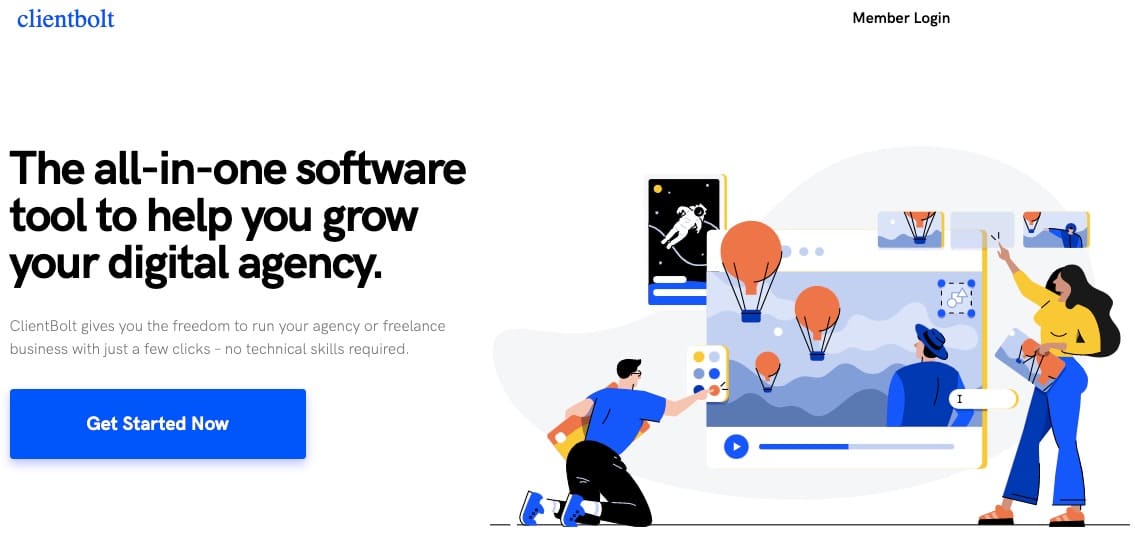
Rather than having to scrape through pages of Google or trying to manually data-mine certain leads, the software does it for you automatically.
We found that our students get a lot better results as a result of us having developed that for them, rather than us just saying ‘Oh, here’s a course, go figure it out.’
So we’re always trying to figure out ways that we can kind of remove those barriers, whether they’re like physical barriers, like trying to find more leads, or if it’s a mental barrier through the use of additional consulting, additional training, or software programs that we’re actively trying to develop that is going to make that process a lot smoother.
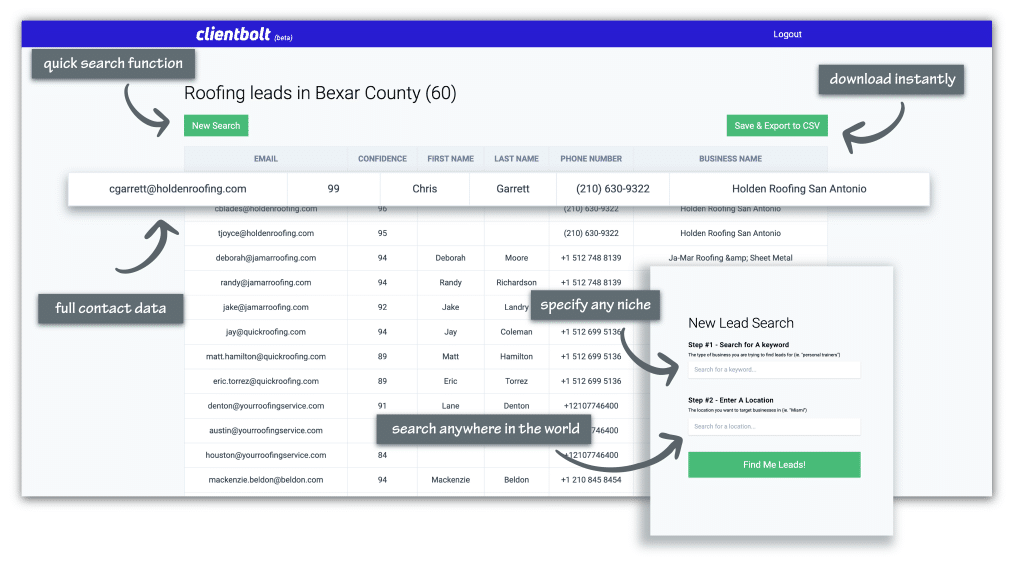
6. For someone who’s never done any sort of online advertising before but has heard that they can build their brand that way. What’s your best advice for them to start?
One of the biggest things that I talk about a lot is that the easiest way to start any business — whether it’s a service business like ours or a product business — is simply to find a starving market and give them what they want.
In my opinion, one of the best things that anyone trying to start a brand, whether it’s through online advertising or otherwise, can do is validate the demand.
See if there are other competitors in this market that are making money. If they are, try to reverse-engineer some of their success. Like, what about them is causing them to do so? What about them is causing them to make so much money?
Figuring out how much money they’re making and how many units they’re selling, that’s going to give you a much bigger head start than just trying to reverse-engineer it from scratch and trying to build a product before actually selling it.
I think that’s one of the biggest mistakes most people make when they’re first getting started.
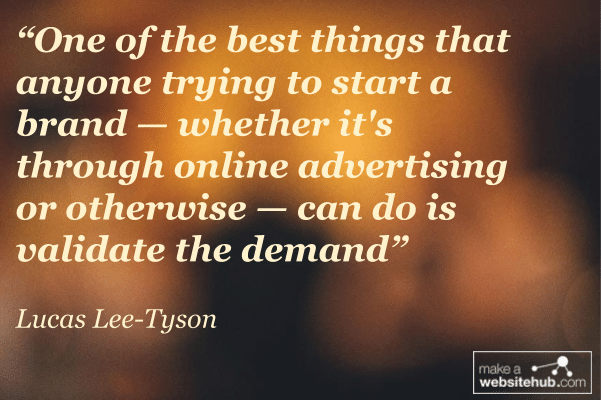
7. I know Facebook is one of the biggest social media platforms for digital marketing. But does Growth Cave cover other social media platforms?
Yeah. We’ve done courses on Google ads, YouTube ads, and Facebook, including Facebook and Instagram ads.
We cover all of the major platforms. It’s interesting cause we actually have a few clients that have recently moved into some of the lesser-known platforms—things like Pinterest ads and TikTok ads.
It’s still in the early stages, but there are many opportunities there from the results that we’re seeing.
So, if we see it as something that might be a long-term strategy that we would want to incorporate with a lot of our clients, we would probably start to develop a lot more training and service around that.
But for now, we cover the major platforms; Facebook, Instagram, Google, YouTube, and so on.
8. What makes Growth Cave stand out from its competitors and why?
It’s a lot of different factors, but I think one of the biggest things is simply because, for a long time, the digital marketing and the digital advertising space has been this black box industry; something that has had a lot of smoke and mirrors around it.
Business owners, people that are buying digital marketing services, a lot of the clients that we worked with have either been burned by a marketing agency or burned by a marketing freelancer in the past who made really big promises and then didn’t live up to them. The students we worked with on the training and consulting side have also had a similar experience.
They’ve bought a course; they’ve hired a coach. They’ve tried to work with a mentor, and it didn’t end up working out as they hoped.
It made us realize that there are so many charlatans in the digital marketing space; people that use flashy Lamborghini’s who try and flash these million-dollar revenue screenshots and basically just say, ‘Oh, you know, if you just pay me this amount of money, you’re going to be here tomorrow.’
A lot of people have felt burned by that, and they’ve kind of become smarter than that. But a lot of people are starting to realize that that stuff simply isn’t realistic, and that’s not how real businesses are built.
In our sales process, both on our agency side and then the training consulting side, we do a really good job of just being honest with people and telling people that digital marketing is not a magic bullet. It’s not something that’s going to make you a million dollars overnight. It’s going to take time, and it’s going to take hard work, but the end result is going to be worth it.
You’re going to have more time; you’re going to have more freedom in your life as a business owner. And you’re going to be able to make more money using the digital marketing strategies that we would implement and teach to you.
That, in my opinion, is one of the biggest differentiating factors. One of the reasons that I think we’ve been able to grow so quickly is that we don’t have to do that much hard selling.
A lot of people out there have been burned by that used car salesman mentality; someone who’s just trying to shove something down their throat and get a quick buck. Whereas we’re very hands-off, we’re not aggressive; we’re not pushy at all.
We’re very much about offering value to people. And then once they see that value, they’re going to be more than happy to pay us. It’s just the natural order of things.
9. Do you use the same marketing strategy for startups and established businesses?
In general, it’s going to be pretty similar. Probably the biggest difference is for an existing business if we were just getting started with them.
One of the biggest goals that we have is trying to uncover what we call hidden profit opportunities, especially if they haven’t done a lot of digital advertising in the past.
In digital marketing, there’s this concept of retargeting; showing ads to people who already know about your brand. Maybe they’ve already purchased from you in the past, or they’ve interacted with you in some way.
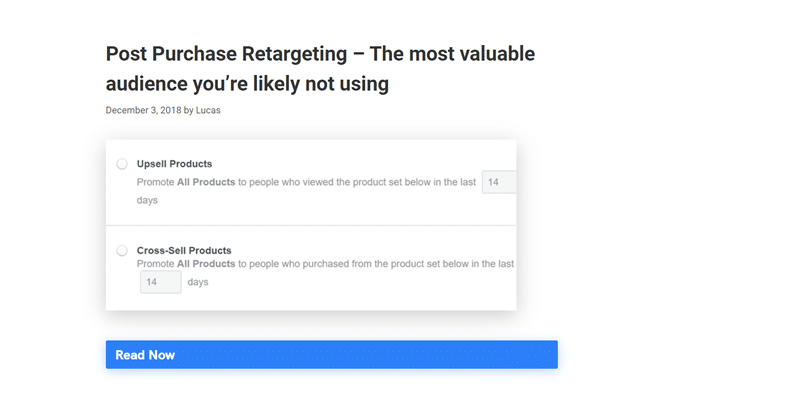
We find that a lot of established businesses, usually in the 1 million to $10 million a year revenue range, aren’t utilizing these audiences effectively as they could. And these are honestly the easiest people to sell to because they already know you, they already trust you, and they already like you to a degree.
With an established business, that’s always our first goal; how can we get them a really quick win? How can we get some profits in the door so we can prove their value to them and then reinvest those profits back into things like cold traffic and top of funnel marketing campaigns?
Obviously, with a startup that doesn’t have a big audience and doesn’t have many existing customers, we can’t do that, which is why our goal there would be to develop a really solid top of the funnel strategy. Something that’s going to indoctrinate a completely cold prospect and turn them into a loyal customer and try to design the funnel around that.
An established business probably already has a decent amount of that legwork done. So the work that we would do for them would be a little bit different. But the end goal is always the same.
We want to come in, and we want to get people quick wins that are going to prove our value. It’s going to make them money, and it’s going to work out best for both of us in the long term.
10. According to a report, 72% of brands say videos improved their conversion rates. How much attention are you paying to video?
We pay a lot of attention to videos. Honestly, videos have been a very large selling point for us because people like consuming videos. YouTube, Instagram, all of these platforms are obviously grown because of that and because you can transmit a lot more information and emotion through a video rather than just an image or a screenshot. So, there’s definitely a ton of value in it.
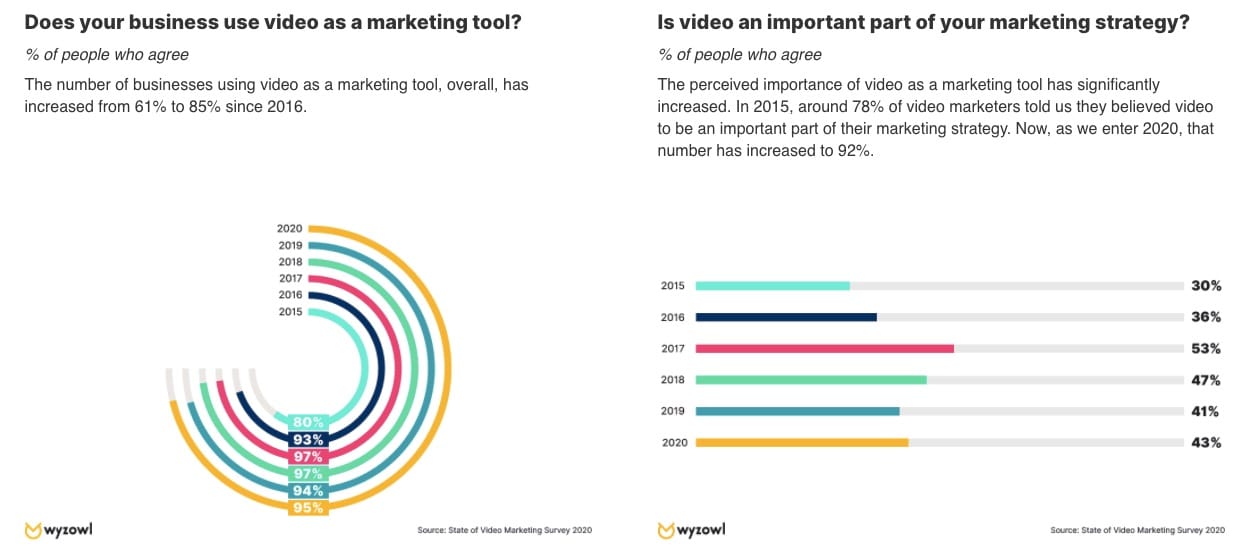
Ultimately, I think one of the most important things with it is just being authentic. There’s a lot of people who think, ‘Oh, I can’t shoot a video ad because I don’t have a fancy camera. I don’t have a camera crew. I don’t have anything like that.’
Some of our top-performing ads for our agency are literally made just walking around their office with an iPhone. It’s just me talking about the most common problems that we see business owners having and what we can do to help solve it.
People react well to that because they’re used to seeing this extremely shiny, glossy, overproduced video ad from a marketer who’s just selling smoke and mirrors and hype, and nothing that’s actually going to get them results.
When you have someone that might have the fanciest setup, but they’re being honest with them and telling them things that not really anyone else’s willing to tell them, it’s going to cut through that noise a lot better.
We find that those videos are super quick to produce. I can pull up my phone, shoot a two to five-minute video ad within the next two to five minutes.
It’s obviously going to depend on the type of business they run and the type of products or services you’re going to be promoting. But honestly, in my opinion, the lower quality you could make it, the better.
Rather than trying to take the overproduced, super high-quality route, just take out your phone, turn it on and start talking. With some basic video editing, I guarantee some solid converting ads that could be made from that.
11. What’s your thought on managing ad blockers and ad fraud?
I definitely think it’s a valid concern, especially on a platform like YouTube, where their ad blocker is pretty efficient.
It’s only a small minority of people that are actually installing ad blockers, probably around 20 to 25% max. And the fact that the majority of web traffic now happens from the phone. I don’t think it’s a huge concern.
Facebook and Google, the two biggest players in online advertising, are billion-dollar companies. They’re going to figure out ways to continue supporting themselves and their business model.
Right now, both of those companies, the majority of their revenue comes from advertising, whether it’s Google ads, YouTube ads, Facebook ads, Instagram ads. So I don’t think it’s a huge concern.
I think one of the bigger concerns along that note is just some of the concerns with some of the court cases Facebook has had in the past with potentially collecting too much user data and tracking people too much. It’ll be interesting to see how that plays out.
But ultimately, these are billion-dollar companies; it’s not like they’re just going to up and disappear the next day. If anything were to happen, it would probably happen over a much larger time span, probably over the next 10 to 25 years. It’s harder for me to make an estimate on what would happen then. But that’s my main concern beyond just ad blockers in general.
About Growth Cave
Growth Cave provides businesses with extensive training and consulting to help them grow online using paid advertising. Owned by Lucas Lee-Tyson, the company works with digital marketers to get new customers and leads with digital advertising.

